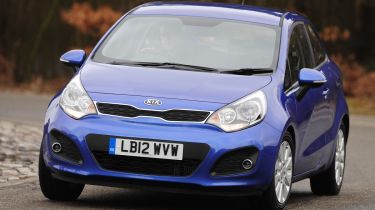Kia Rio 1.1 CRDi 1
Classy looks and quality finish provide real upmarket appeal
The Rio is an excellent supermini, with a quality feel that the Sandero can only dream of. But the focus is on high economy and low emissions, and this means the Kia’s day-to-day driving experience is compromised. The miserly level of kit is pulled into focus by the Sandero, too.
While the Sandero looks and feels like a budget car, that’s not a criticism you can level at the Kia Rio. The bold nose, rising waistline and short rear overhang give it a thoroughly modern look, and even the entry-level 1 model is handsome.
Climb inside, and there’s an air of quality that the Dacia can’t come close to. There’s a lot of black plastic, but it’s of a high quality, and the controls feel classy, too. As with the Sandero, you get a USB connection, but it’s located more conveniently ahead of the gearlever, and there’s a handy recess below it to hold a portable music device, so you’re not left with wires trailing across the cabin.
It’s easy to get comfortable at the wheel, too, as there’s a height-adjustable driver’s seat and the wheel moves for rake. The car in our pictures is a three-door, but rear headroom is the same as in the spacious five-door, although the Sandero has more legroom.
Used - available now

2023 Volkswagen
Tiguan
30,898 milesAutomaticPetrol1.5L
Cash £24,049
2023 Vauxhall
Corsa
12,500 milesManualPetrol1.2L
Cash £12,699
2018 BMW
3 Series
81,470 milesAutomaticPetrol2.0L
Cash £11,000
2016 Tesla
Model S
78,000 milesAutomaticElectric
Cash £18,999The 1.1-litre three-cylinder diesel has only 1bhp less than the Panda’s engine, at 74bhp, but the disparity in performance is stark. While the Rio is fitted with a six-speed box, the ratios are widely spaced to maximise efficiency, and as a result it took a lethargic 13.6 seconds to accelerate from 0-60mph. In-gear performance was equally slow.
In corners, there’s plenty of grip and the Rio feels composed, but it’s not much fun. In reality, its forte is as a comfortable cruiser. The three-cylinder diesel is never raucous, and you can happily cruise all day at motorway speeds, because the Rio has a rock-solid feel that puts it a notch above its rivals.
In town, the suspension is a little on the firm side, but again, the Rio feels well built, so takes knocks and thumps in its stride. We only spent a short time with the Kia, but the 43.3mpg we achieved on test was well short of the official claims of 88.3mpg. Part of that can be put down to the long gearing, because in everyday use we found we needed to hold on to the revs for longer to keep pace with traffic.
The rest of the Rio’s financial case is a mixed bag. Entry-level 1 models cost £11,895, but you don’t get much kit, although electric mirrors, a tilt-adjustable wheel and trip computer are all standard. If you want more, Kia doesn’t offer many options – you have to upgrade to a higher-spec model instead.
An emissions figure of 85g/km is impressive, and it means the Rio is exempt from road tax, while insurance and company car tax costs are competitive. Add in strong residuals, plus Kia’s seven-year warranty, and the Rio makes strong financial sense. Is that enough to compensate for the price gap between it and the Sandero?







